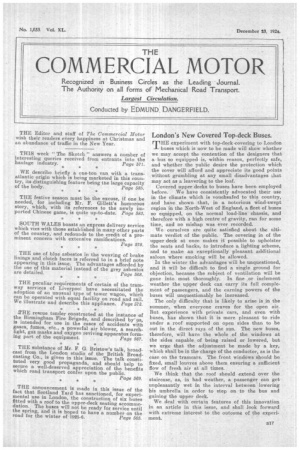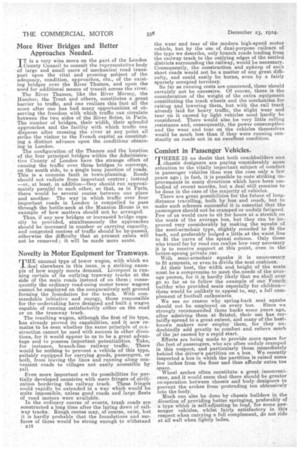London's New Covered Top-deck Buses.
Page 1

Page 2

If you've noticed an error in this article please click here to report it so we can fix it.
THE experiment with top-deck .covering to London buses which is now to be made will show whether we may accept the contention of the designers that a bus so equipped is, within reason, perfectly safe, and whether the public desire the protection which the cover will afford and appreciate its good points without grumbling at any small disadvantages that may act as a leavening to the loaf. Covered upper decks to buses have been employed before. We have consistently advocated their use in the climate which is vouchsafed to this country, and have shown that, in a notorious wind-swept region in the North-West of England, a fleet of buses so equipped, on the normal load-line chassis, and therefore with a high centre of gravity, ran for some time, and no mishap was ever recorded. We ourselves are quite satisfied about the ultimate verdict of the public. The covering in of the upper deck at once makes it possible to upholster the seats and hacks, to introduce a lighting scheme, and to make an exceptionally pleasant additional saloon where smoking will be allowed. In the winter the advantages will be unquestioned, and it will be difficult to find a single ground for objection, because the subject of ventilation will be gone into most thoroughly. In fine or inclement weather the upper deck can carry its full complement of passengers, and the earning powers of the buses will unquestionably be increased. The only difficulty that is likely to arise is in the summer, when everyone craves for the open air. But experience with private cars, and even with buses, has shown that it is more pleasant to ride under a roof supported on open sides than to be out in the direct rays of the sun. The new buses, therefore, will have the whole of the windows at the sides capable of being raised or lowered, but we urge that the adjustment be made by a key, which shall be in the charge of the conductor, as is the case on the tramcars. The front windows should be fixed, small louvres above them ensuring a sufficient flow of fresh air at all times. We think that the roof should extend over the staircase, as, in bad weather, a passenger can get unpleasantly wet in the interval between lowering his umbrella in order to step on to the bus and gaining the upper deck. We deal with certain features of this innovation in an article in this issue, and shall look forward with extreme interest to the outcome of the experiment. More River Bridges and Better
Approaches Needed. •
IT is a very wise move on the part of the London County Council to consult the representative body of large and small users of mechanical road transport upon the vital and pressing subject of the adequacy, condition, approaches, etc., of the existing bridges Over the River Thames, and upon the need for additional means of transit across the river.
The River Thames, like the River Mersey, the Humber, the Trent and others, constitutes a great barrier to traffic, and one realizes this fact all the more after one has had many opportunities of observing the freedom with which traffic can circulate between the two sides of the River Seine, in Paris. The number of bridges, their width, their splendid approaches and the facility with which traffic can disperse alter crossing the river at any point all strike the visitor to the French capital as constituting a distinct advance upon the conditions obtaining -in London.
The configuration of the Thames and the location of the four principal bridges within the Administrative County of London have the strange effect of causing the traffic over those bridges to converge, on the south side, to a single busy junction of roads. This is a common fault in town-planning. Roads should not radiate from important centres ; instead —or, at least, in addition—they should run approximately parallel to each other, so that, as in Paris, there would be several routes between one place and another. The way in which traffic over four important roads in London is compelled to pass through the bottle-neck at the Mansion House is an example of how matters should not be arranged.
Thus, if any new bridges or increased bridge capacity he provided, simultaneously the approaches should be increased in number or carrying capacity, and congested centres of traffic should be by-passed, otherwise the difficulty that at present exists will not be removed ; it will be made more acute.
Novelty in Motor Equipment for Tramways.
HE unusual type of tower wagon, with which we _L deal elsewhere in this issue, is a striking example of how supply meets demand. Liverpool is running certain of its outlying tramway tracks at the side of the main roads instead of on them ; consequently the ordinary road-using motor tower wagons cannot be employed on the comparatively soft ground forming the foundation for the track. With commendable initiative and energy, those responsible for the undertaking have designed and built a wagon capable of running satisfactorily either on the road or on the tramway track.
The resulting wagon, although the first of its type, has already proved its capabilities, and it now remains to be seen whether the same principle of ccnstruction cannot be used with success in other directions, for it would appear to us to be a great advantage and to possess important potentialities. Take, for instance, branch-line railway traffic. There would be nothing to prevent a vehicle of this type, suitably equipped for carrying goods, passengers, or both, from leaving the lines and running along convenient roads to villages not easily accessible by rail.
Even more important are its possibilities for partially developed countries with mere fringes of civilization bordering the railway track. These fringes could rapidly be extended in a way which would be quite impossible, unless good roads and large fleets of road motors were available.
In the ordinary course of events, trunk roads are constructed a long time after the laying down of railway tracks. Rough routes may, of course, exist, but it is hardly probable that the foundations and surfaces of these would be strong enough to withstand the wear and tear of the modern high-speed motor vehicle, but by the use of dual-purpose railcars of the type we describe, only branch roads leading from the railway track to the outlying edges of the settled districts surrounding the railway, would be necessary. Consequently, the construction and upkeep of such short roads would not be a matter of any great difficulty, and could easily be borne, even by a fairly sparsely occupied territory. So far as running costs are concerned, these should certainly not be excessive. Of course, there is the consideration of the weight of the extra equipment constituting the track wheels and the mechanism for raising and lowering them but with the rail track already laid for heavy traffic, the Slight wear and tear on it caused by light vehicles need hardly be considered. There would also be very little rolling resistance and, consequently, the power consumption and the wear and tear on the vehicles themselves would be much less than if they were running constantly on roads not in an excellent condition.
Comfort in Passenger Vehicles.
rTIHERE IS no doubt that both coachbuilders aria 1 chassis designers are paying considerably more attention to the vitally important subject of comfort in passenger vehicles than was the case only a few years ago ; in fact, it is possible to note striking improvements in many directions which have been embodied of recent months, but a deal still remains to be done in the case of the majority of vehicles.
There are great possibilities for the future of longdistance travelling, both by bus and coach, but to make such schemes successful it is essential that the passengers should not he cramped or unduly fatigued. Few of us would care to sit for hours at a stretch on the seats of the average bus, but they can be improved very considerably by making the squabs of the semi-armchair type, slightly rounded to fit the back, and preferably bulged a little at the waist line to fit the curve of the spinal column. Only those who travel far by road can realize how very necessary it is to receive support at this point, even in the better-sprung private car. With semi-armchair squabs it is unnecessary to fit armrests, or even to divide the seat cushions.
At their best, the width and height of the seats must be a compromise to meet the needs of the average person, for it is hardly likely that we shall ever go so far as to follow the example of one French builder who provided seats especially for children— these would be unlikely to appeal to, say, a full complement of football enthusiasts.
We see no reason why spring-back seat squabs should not be employed on every bus. Since we strongly recommended these backs some years ago, after admiring them at Bristol, their use has certairly spread to a great extent, and many of the bestknown makers now employ them, for they undoubtedly add greatly to comfort and relieve much of the jar caused by a rapid start. Efforts are being made to provide more space for the feet of passengers, who are often unduly cramped in this respect, and particularly those immediately behind the driver's partition on a bus. We recently inspected a bus in which the partition is raised some few inches from the floor and thus affords extra toe space. Wheel arches often constitute a great. inconvenience, and it would seem that there should be greater co-operation between chassis and body designers to prevent the arches from protruding too obtrusively into the body. Much can also be done by chassis builders in the direction of providing better springing, preferably of a type which is self-adjusting to load, for some passenger vehicles, whilst fairly satisfactory in this respect when carrying a full complement, do not ride at all well when lightly laden.
































